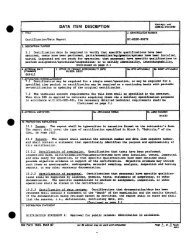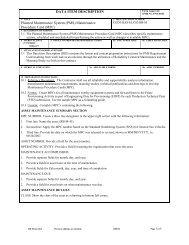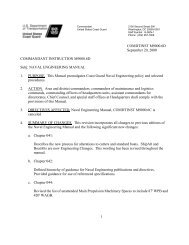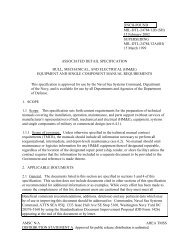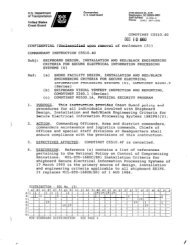comdtinst m2400.1f - US Coast Guard Response Boat-Medium
comdtinst m2400.1f - US Coast Guard Response Boat-Medium
comdtinst m2400.1f - US Coast Guard Response Boat-Medium
Create successful ePaper yourself
Turn your PDF publications into a flip-book with our unique Google optimized e-Paper software.
COMDTINST M2400.1F<br />
CHAPTER 1. GENERAL INFORMATION<br />
A. Purpose. COMDTINST M2400.1 (series) is the basic U.S. <strong>Coast</strong><br />
<strong>Guard</strong> Radio Frequency Plan and contains radio frequencies for U.S.<br />
<strong>Coast</strong> <strong>Guard</strong> use. It is issued for the use and guidance of<br />
responsible commanders in formulating supplementary plans and is<br />
furnished to lower echelons for information and planning purposes.<br />
COMDTINST M2400.1 (series) is a radio frequency plan and does not<br />
constitute a radio frequency authorization to operate unless<br />
specifically indicated. Authorization for federal government<br />
stations to use radio frequencies is granted by the National<br />
Telecommunications and Information Administration (NTIA) and specific<br />
assignments are listed in the Government Master File (GMF).<br />
B. General.<br />
1. Information. This publication provides explanatory<br />
information concerning application procedures for use of radio<br />
frequencies, a frequency index and lists of circuits.<br />
a. Frequency Index. The frequency index is a listing of<br />
all radio frequencies assigned by the Commandant for <strong>Coast</strong><br />
<strong>Guard</strong>, and indicates the circuit designator for each of<br />
these assigned radio frequencies.<br />
b. Annexes. The list of circuits is divided into annexes<br />
denoting its function, and each circuit in a particular<br />
annex is arranged in circuit designator order. The<br />
circuit details normally include a descriptive title, a<br />
list of assigned radio frequencies and any special<br />
instructions governing the use of these frequencies.<br />
c. Circuit Designator. The circuit designators within<br />
the "B", "P", "Q", and "Z" annexes are arranged by <strong>Coast</strong><br />
<strong>Guard</strong> District whenever the circuit is confined to an<br />
individual district (e.g., a "P05.01" circuit would<br />
indicate a fixed circuit in the Fifth <strong>Coast</strong> <strong>Guard</strong><br />
District). Whenever the circuit is not restricted to a<br />
particular district, it is assigned a circuit<br />
designator "18" or higher. (e.g., "P18", "Q20", etc.).<br />
d. Circuits. The circuits within the remaining annexes<br />
are arranged by type in circuit designator order; e.g.<br />
"A01" is the Primary Ship-Shore Circuit, and "A01.01" and<br />
"A01.02" are sub-divisions of the Primary Ship-Shore<br />
Circuit indicating HF Ship-Shore Circuits for the<br />
Atlantic and Pacific Areas respectively.<br />
2. Designating Symbol. The designating symbol will normally be<br />
used to identify circuits and radio frequencies in messages,<br />
letters, instructions or other documents; e.g. "A13.02" is the<br />
circuit designator for the High Seas Radiotelephone Service,<br />
"4370.4 kHz" is one of the several radio frequencies assigned<br />
to this circuit.<br />
1-1





